
By Andreas Neumann, Erlangen Center for Islam & Law in Europe (EZIRE)
Recently, at one of the many German universities of excellence (names do not matter), students and other citizens were invited to a lecture with the title: “Stoning: a Non-Islamic tradition.†The hosts were the Seminar for Arab and Islamic Studies and the Institute of Criminal Sciences. The picture represented here is taken from the poster hanging all over the campus and also in the city. At its center, you see a huge hand on the point of casting a crude edged stone in the direction of the observer. In the foreground, there is an olive branch. The colors in the background evoke the national flag of Iran flying in wind. A short analysis might be fruitful. The picture is an example of contemporaneous stereotyped thinking and also transports a message contrary to the requirements of reason.
The hand, disambiguated by the context, symbolizes the gruesome act. It is combined with the enlarged olive branch. The olive branch was a symbol of peace in Greek and Roman antiquity, when it also was worn as an adornment by brides. Retrospectively, it was associated with Noah who sent out a dove which returned with an olive leaf in its beak (which became a branch in the Vulgate). This sign indicated that the water was receding. There might exist an older model of this image, since the association of the dove, the olive branch or even the rainbow with peace does not follow conclusively from the text. The Quran has not taken it over in its frequent references to the Genesis version of the story of the Flood (also see the account by Heinrich Speyer, Die biblischen Erzählungen im Qoran, Gräfenhainichen 1931, pp. 89-115). Nevertheless, the olive tree (by the way, in German more often called “Ölbaumâ€, oil tree) is cited several times in the Quran, especially in the beautiful verse of the light, Q 24:35, where the blessed olive tree in question is characterized as neither Eastern nor Western (cf. Zechariah 4:3-11). The olive branch has become an international symbol of peace and is represented on the emblem of the United Nations, where two of them symmetrically embrace a map of the world. “The Olive Branch†was the title of a novel on love and honor by the Egyptian writer Muhammad Abdalhalim Abdallah (mid-20th century). A detailed history of the sources and development of the symbols of peace remains to be written.
The olive branch here obviously is intended to express the command of international human rights to stop the practice of stoning, which unfortunately still exists in some countries. Already in the legal orders which influenced the Old Testament, the punishment of stoning was the usual way of the public authority to execute the death penalty in cases which were considered as severe disturbances of the public order and not simply private affairs. The Torah explicitly prescribes it for certain cases, and the New Testament takes it for granted. According to the written text of the Quran, fornicators are sentenced to lashes. Islamic jurists developed the legal foundations for stoning. They partly based it on several contested traditions of the originally oral traditions on the deeds, sayings and tacit approval of the Islamic prophet Muhammad. In need of a stronger basis in the setting of the more developed Islamic legal theory, divergent stories of a lost “stoning verse†later gained in importance. This verse is said to have been abrogated in its recited text, but not in its authoritative meaning, so that it could abrogate the punishment of lashing prescribed by the Quran (see Mathias Rohe, Das islamische Recht, München 2010, pp. 51, 125, 263). It goes without saying that any form of physical punishment is unacceptable today. States marked by Islam have revived or even re-invented Islamic legal tradition in the course of reforms aiming at corroborating their independence from the former colonial powers and an “Islamic†identity. Iran introduced stoning as a punishment for fornication three years after the “Islamic revolution,†simplifying the extremely high procedural demands of Islamic evidence law.
The picture is provocative and is meant to attract a large audience. But it overshoots the mark. Many observers will presumably add a question mark to the title of the lecture. The interpretation of the olive branch sketched above is not compelling. On the one hand, one might even argue that the application of the limit-penalties (named after the limits set up by God in the Quran, other examples being slander, theft, and drinking alcohol) is portrayed as a way to peace. The poster in this vein becomes a tasteless piece of propaganda, however well intentioned. On the other hand, the ongoing juxtaposition of “Islam†and “stoning†will deepen the widespread prejudices and misconceptions about the religion itself. Indeed, fairly balanced information and differentiated learning and teaching on Islam still are rare.
Andreas Neumann is a contributor to the blog Access to Mideast and Islamic Resources (AMIR).